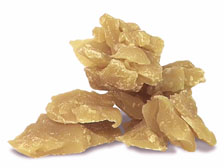Marking time in September 2004
Pine resin
Discussion of the ingredients of cutler’s resin continued on the oldtools list today. Steven Longley has turned up an American supplier of pine resin, also called brewer’s pitch. You can buy it from Jas Townsend & Son, Inc.
Daniel E L Yurwit added this to the exchange:
FWIW, the Apache also made jugs woven from plant fiber (a “tuss”) to carry water, and coated them heavily with pine tar resin to waterproof them. Some still work effectively 100+ years later.

But there’s more. Ryan McNabb had this to say:
The Kirby Paint Company, a family owned marine paint concern, has the Real Deal - genuine pine tar the likes of which you’ve never seen unless you’ve served with Lucky Jack on the HMS Surprise. Thick enough to float a hammer and with a smell like Heaven on steroids.Friday Update: Jerry Davis added this from the southern USA…
If you live in a rural area, check with your local farm supply store (aka feed store). Mine sells pine tar in small (8 oz) cans. It is handy for dressing wounds, applying to horn stubs after dehorning and lots of other uses.
…and BugBear came up with a link to Pine tar; history and uses on the San Fransciso Maritime National Park website:
Few visitors to any ship which as been rigged in a traditional manner have left the vessel without experiencing the aroma of pine tar. The aroma produces reactions that are as strong as the scent; few people are ambivalent about its distinctive smell. As professionals engaged in the restoration and maintenance of old ships, we should know not only about this product, but also some of its history.
Cutler’s resin
Pardon me, as I jot down a recipe. Cutler’s resin is 8 oz pine pitch, 1/4 cup carnauba wax and 4 oz of beeswax, melted together in a double boiler and used hot. Mark Marsay wrote on the oldtools mailing list:
I usually use cutlers resin when attaching handles to blades — seems to work better than epoxy with the marking knives and various odd shaped scraper knives and chip carving knives I sometimes make.
Someone asked why this concoction is better than epoxy. Mark gave his reasons:
Well, apart from the galootishness of it, it is probably the best glue for attaching dissimilar materials I have come across. It holds like mad, yet has enough flex to allow differential expansion, and it doesn’t creep, allowing you to use it on bone or ivory without staining. It is also a huge amount easier to clean up runs and squelches than epoxy is. As you are in the UK, you can get pine pitch from Baldwins, just off the Elephant and Castle. … BTW, Baldwins are also good for most natural colouring agents - I get all my alkanet and logwood from them!